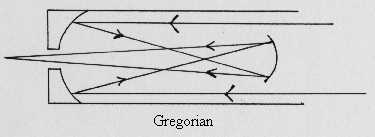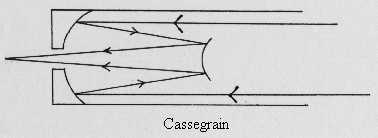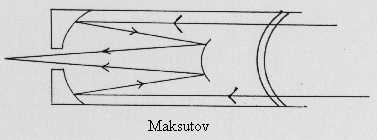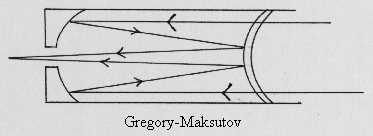
From James Gregory to John
Gregory
The 300 Year Evolution of the Maksutov-Cassegrain Telescope
In 1663 a Scottish mathematician named James Gregory designed the first reflecting telescope, envisioning a small secondary mirror that reflected light through a hole drilled in the main mirror. The design also called for two concave mirrors, with the secondary mirror placed beyond (outside) the focal point of the main mirror. Unfortunately, the technology of the mid-1600's could not manufacture precise enough mirrors to turn Gregory's design into a working instrument.

In 1672 a Frenchman named Cassegrain wrote to the Paris Academy of Sciences on the topic of the megaphone. In a cover letter to Cassegrain's paper, Henri de Berce of Chartres also described a reflecting telescope designed by Cassegrain. The main differences between Cassegrain's design and that of Gregory was that Cassegrain used a convex secondary mirror and moved it inside the focal point of the main mirror.

Nearly 260 years passed before the next major development took place. This was in 1930 when an Estonian astronomer, lens and mirror maker, Bernard Schmidt, developed a lens called a 'corrector plate' that would compensate for the Cassegrain's optical distortion - specifically it corrected for spherical aberration. This arrangement was the first lens and mirror - or catadioptric - telescope and was used for astronomical photography. In the Schmidt Camera, a curved photographic plate holder was positioned at the focal plane of the main mirror for maximum sharpness. Later the Schmidt Corrector Plate was applied to the Cassegrain design and the Schmidt-Cassegrain Telescope was born.

Eleven years later, two men, A. Bouwers of Amsterdam, Holland, in February of 1941 and Dmitry Maksutov of Moscow, Russia, in October of 1941 independently conceived the idea of replacing Schmidt's complexly shaped corrector plate with a curved lens, called the Meniscus Corrector Shell. This shell also corrected for the spherical aberration and was easier to manufacture which opened the way for the telescope we have come to know as the Maksutov-Cassegrain.

Then, in 1957, an optical engineer, coincidentally named John Gregory, developed further refinements in the Maksutov-Cassegrain design. Most notably he did away with the separate secondary mirror and replaced it with a mirrored spot on the corrector shell itself. This brings us to the modern instrument which could be called the Gregory-Maksutov-Bouwers-Schmidt-Cassegrain-Gregory telescope, but which most people simply call the 'Mak.'

For Further Information:
Dictionary of Scientific Biography. ed. Charles
Gillispie. Scribner, 1981.
Harrington, Philip S. Star Ware. John Wiley & Sons, 1994.
Learner, Richard. Astronomy through the Telescope. Van Nostrand,
1981.
Muirden, James. Beginner's Guide to Astronomical Telescope
Making. Simon & Schuster, 1988.
How to Use an Astronomical Telescope. Simon & Schuster, 1985.
Thompson, Allyn J. Making Your Own Telescope. Sky Publishing
Corp, 1973.
Traister, Robert J. Astronomy and Telescopes. TAB Books, 1983.
Copyright 1998, John F. Gills, Ph.D., johnfgills@worldnet.att.net Permission given for individual reproduction when the author's credit and bibliography are included. Illustrations by the author.
Web page enhancements by Lew Worthem, lworthem@mcs.net